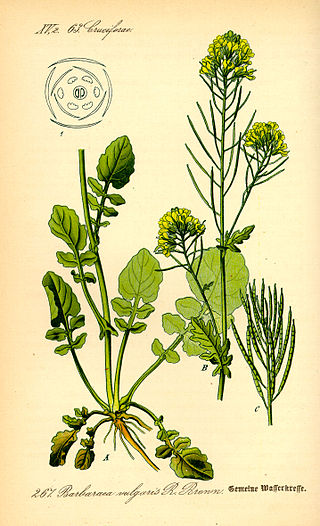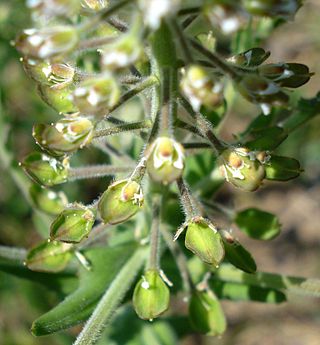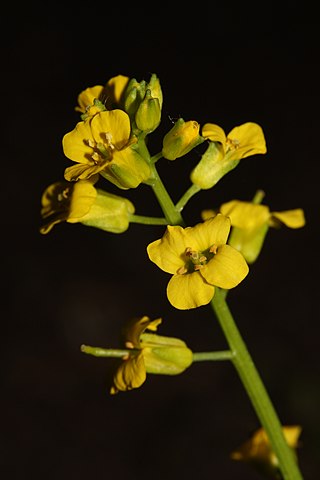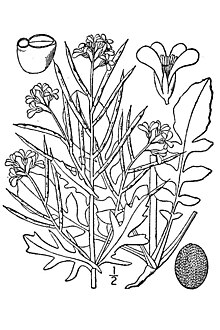
Brassicaceae or Cruciferae is a medium-sized and economically important family of flowering plants commonly known as the mustards, the crucifers, or the cabbage family. Most are herbaceous plants, while some are shrubs. The leaves are simple, lack stipules, and appear alternately on stems or in rosettes. The inflorescences are terminal and lack bracts. The flowers have four free sepals, four free alternating petals, two shorter free stamens and four longer free stamens. The fruit has seeds in rows, divided by a thin wall.

Watercress or yellowcress is a species of aquatic flowering plant in the cabbage family Brassicaceae.

Cress, sometimes referred to as garden cress to distinguish it from similar plants also referred to as cress, is a rather fast-growing, edible herb.

Cardamine is a large genus of flowering plants in the mustard family, Brassicaceae, known as bittercresses and toothworts. It contains more than 200 species of annuals and perennials. Species in this genus can be found in diverse habitats worldwide, except the Antarctic. The name Cardamine is derived from the Greek kardaminē, water cress, from kardamon, pepper grass.

Leaf vegetables, also called leafy greens, pot herbs, vegetable greens, or simply greens, are plant leaves eaten as a vegetable, sometimes accompanied by tender petioles and shoots. Leaf vegetables eaten raw in a salad can be called salad greens.

Barbarea is a genus of about 22 species of flowering plants in the family Brassicaceae, native to temperate regions of the Northern Hemisphere, with the highest species diversity in southern Europe and southwest Asia. They are small, herbaceous, biennial or perennial plants with dark green, deeply lobed leaves and yellow flowers with four petals.

Raphanus raphanistrum, also known as wild radish, white charlock or jointed charlock, is a flowering plant in the family Brassicaceae. One of its subspecies, Raphanus raphanistrum subsp. sativus, includes a diverse variety of cultivated radishes. The species is native to western Asia, Europe and parts of Northern Africa. It has been introduced into most parts of the world and is regarded as a habitat threatening invasive species in many areas, for example, Australia. It spreads rapidly and is often found growing on roadsides or in other places where the ground has been disturbed.

Lepidium campestre, the field pepperwort or field pepperweed or field cress, is usually a biennial with some form of annual plant in the Brassicaceae or mustard family, native to Europe, but commonly found in North America as an invasive weed. The most notable characteristic of field pepperweed is the raceme of flowers which forks off of the stem. These racemes are made up of first small white flowers and later green, flat and oval seedpods each about 6 mm long and 4 mm wide. Each seedpod contains two brown, 2.5 mm long seeds.

Cardamine hirsuta, commonly called hairy bittercress, is an annual or biennial species of plant in the family Brassicaceae, and is edible as a salad green. It is common in moist areas around the world.

Barbarea vulgaris, also called wintercress, or alternatively winter rocket, rocketcress, yellow rocketcress, yellow rocket, wound rocket, herb barbara, creases, or creasy greens, is a biennial herb of the genus Barbarea, belonging to the family Brassicaceae.

Tropaeolum majus, the garden nasturtium, nasturtium, Indian cress or monk's cress, is a species of flowering plant in the family Tropaeolaceae, originating in the Andes from Bolivia north to Colombia. An easily-grown annual or short-lived perennial with disc-shaped leaves and brilliant yellow, orange or red flowers, it is of cultivated, probably hybrid origin. It is not closely related to the genus Nasturtium.

Draba verna, common whitlowgrass, is a species of plant in the cabbage family. It is a small spring-flowering annual which is widely dispersed around the world, and which is found on walls, pavements and patches of bare ground. It has a complex taxonomy which is not yet fully elucidated.

Erysimum cheiri, syn. Cheiranthus cheiri, the wallflower, is a species of flowering plant in the family Brassicaceae (Cruciferae), native to Greece, but widespread as an introduced species elsewhere. It is also treated as a hybrid under the name Erysimum × cheiri. It is widely cultivated as a garden plant.

Lactuca canadensis is a species of wild lettuce known by the common names Canada lettuce, Canada wild lettuce, and tall lettuce. Its true native range is not clear, but it is considered to be a native of the eastern and central parts of North America. It naturalized in the western part of the continent as well as in Eurasia.

Barbarea orthoceras is a species of flowering plant in the family Brassicaceae known by the common name American yellowrocket. It is native to North America, including much of Canada and the western United States, as well as parts of Asia. It grows in moist areas such as meadows and riverbanks. This is a perennial herb producing a stiff, branching stem to heights between 10 and 60 centimeters. The leaves are a few centimeters long and generally oval in shape with several rounded lobes toward the end. The inflorescence is a spike or cluster of bright yellow flowers at the tip of each stem branch. The fruit is a straight, narrow silique up to 5 centimeters long.

Lepidium didymum, the lesser swine-cress, is a species of flowering plant in the family Brassicaceae.

Rorippa palustris, marsh yellow cress, is a species of flowering plant in the family Brassicaceae. It is widespread and native to parts of Africa, and much of Asia, Europe and Eurasia, North America and the Caribbean. It can also be found in other parts of the world as an introduced species and a common weed, for example, in Australia and South America. It is an adaptable plant which grows in many types of damp, wet, and aquatic habitat. It may be an annual, biennial, or perennial plant, and is variable in appearance as well.

Barbarea stricta, the small-flowered winter-cress, is a species of plant in the family Brassicaceae.

Lepidium coronopus,, is a species of flowering plant in the mustard family which is native to parts of Africa, western Asia and Europe, growing in shingle banks, wasteland or cultivated fields.





















